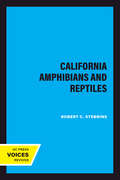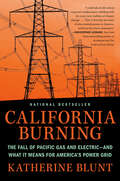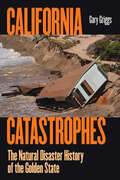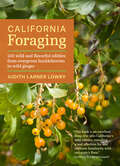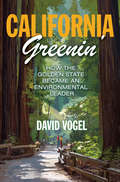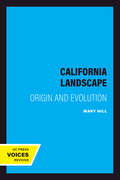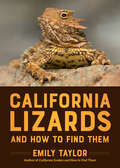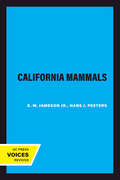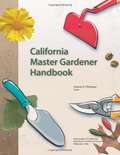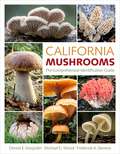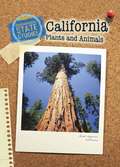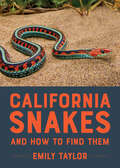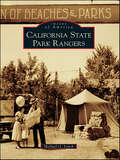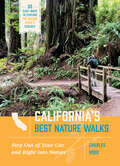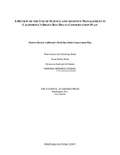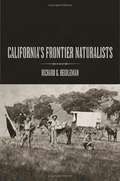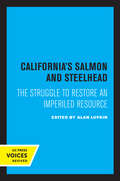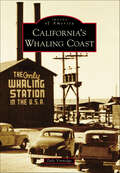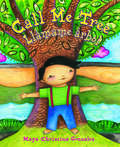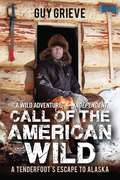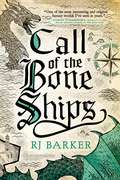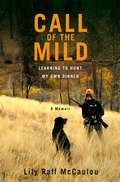- Table View
- List View
California Amphibians and Reptiles: Revised Edition (California Natural History Guides #31)
by Robert C. StebbinsThis title is part of UC Press's Voices Revived program, which commemorates University of California Press’s mission to seek out and cultivate the brightest minds and give them voice, reach, and impact. Drawing on a backlist dating to 1893, Voices Revived makes high-quality, peer-reviewed scholarship accessible once again using print-on-demand technology. This title was originally published in 1972.This title is part of UC Press's Voices Revived program, which commemorates University of California Press’s mission to seek out and cultivate the brightest minds and give them voice, reach, and impact. Drawing on a backlist dating to 1893, Voices Revived</DIV
California Blue
by David KlassJohn Rodgers never wanted to be a football star like his father. He prefers the solitude of distance running. It helps him gather his thoughts. John's been doing a lot of thinking lately, now that he's learned of his father's leukemia. In the midst of the pain and confusion, John makes a remarkable discovery: butterflies. Beautiful blue butterflies like none he has seen before. No one else has seen them before, either. It should be a reason to celebrate. But John discovered the butterfly on the property of the local lumber mill, which employs most of his neighbors - and his father. If the government decides that the butterfly should be protected, the mill will have to close. John's little secret could make him the town's worst enemy - and the shame of his dying father. Now John must decide how far he's willing to go for his discovery: the amazing California Blue. David Klass's gripping and passionate novel brings to life the faces and heated emotions found on both sides of an environmental battlefield.
California Burning: The Fall of Pacific Gas and Electric--and What It Means for America's Power Grid
by Katherine BluntA revelatory, urgent narrative with national implications, exploring the decline of California&’s largest utility company that led to countless wildfires — including the one that destroyed the town of Paradise — and the human cost of infrastructure failurePacific Gas and Electric was a legacy company built by innovators and visionaries, establishing California as a desirable home and economic powerhouse. In California Burning, Wall Street Journal reporter and Pulitzer finalist Katherine Blunt examines how that legacy fell apart—unraveling a long history of deadly failures in which Pacific Gas and Electric endangered millions of Northern Californians, through criminal neglect of its infrastructure. As PG&E prioritized profits and politics, power lines went unchecked—until a rusted hook purchased for 56 cents in 1921 split in two, sparking the deadliest wildfire in California history.Beginning with PG&E&’s public reckoning after the Paradise fire, Blunt chronicles the evolution of PG&E&’s shareholder base, from innovators who built some of California's first long-distance power lines to aggressive investors keen on reaping dividends. Following key players through pivotal decisions and legal battles, California Burning reveals the forces that shaped the plight of PG&E: deregulation and market-gaming led by Enron Corp., an unyielding push for renewable energy, and a swift increase in wildfire risk throughout the West, while regulators and lawmakers pushed their own agendas.California Burning is a deeply reported, character-driven narrative, the story of a disaster expanding into a much bigger exploration of accountability. It&’s an American tragedy that serves as a cautionary tale for utilities across the nation—especially as climate change makes aging infrastructure more vulnerable, with potentially fatal consequences.
California Catastrophes: The Natural Disaster History of the Golden State
by Gary GriggsThis comprehensive account of California’s numerous and perilous natural disasters explores how a unique combination of forces has affected Californians throughout the state's history and carries a sobering message about our short disaster memories. California has more natural hazards per square mile than any other state, but this hasn’t deterred people from moving here. Entire California towns and regions frequently contend with destruction caused by earthquakes, floods, landslides and debris flows, and sea-level rise and coastal erosion. As Gary Griggs demonstrates in California Catastrophes, few years go by without a disaster of some kind, and residents often rebuild in the same locations that were just destroyed. Considering the current climate crisis and increasing environmental inequalities, the stakes are growing ever higher. This book dives into the history of the state’s vulnerability to natural hazards, why and where these events occur, and how Californians can better prepare going forward. A mix of photographs and maps both historical and contemporary orients readers within the state’s sprawling landscapes and provides glimpses of some of the geologic risks in each region. With the final chapter, Griggs issues a call to action and challenges readers to envision a safer, more equitable, and sustainable future.
California Foraging: 120 Wild and Flavorful Edibles from Evergreen Huckleberries to Wild Ginger (Regional Foraging Series)
by Judith Lowry“This book is an excellent deep dive into California’s wild edibles, revealing a real affection for and intimate familiarity with our state’s flora.” —Iso Rabins, founder of ForageSF California offers a veritable feast for foragers, and with Judith Larner Lowry as your trusted guide you will learn how to safely find and identify an abundance of delicious wild plants. The plant profiles in California Foraging include clear, color photographs, identification tips, guidance on how to ethically harvest, and suggestions for eating and preserving. A handy seasonal planner details which plants are available during every season. Thorough, comprehensive, and safe, this is a must-have for foragers in the Golden State.
California Forest Transect
by Arthur W. PetersonA review of common tree species across central California
California Greenin': How the Golden State Became an Environmental Leader (Princeton Studies in American Politics: Historical, International, and Comparative Perspectives #157)
by David VogelA political history of environmental policy and regulation in California, from the Gold Rush to the presentOver the course of its 150-year history, California has successfully protected its scenic wilderness areas, restricted coastal oil drilling, regulated automobile emissions, preserved coastal access, improved energy efficiency, and, most recently, addressed global climate change. How has this state, more than any other, enacted so many innovative and stringent environmental regulations over such a long period of time? The first comprehensive look at California's history of environmental leadership, California Greenin' shows why the Golden State has been at the forefront in setting new environmental standards, often leading the rest of the nation.From the establishment of Yosemite, America's first protected wilderness, and the prohibition of dumping gold-mining debris in the nineteenth century to sweeping climate- change legislation in the twenty-first, David Vogel traces California's remarkable environmental policy trajectory. He explains that this pathbreaking role developed because California had more to lose from environmental deterioration and more to gain from preserving its stunning natural geography. As a result, citizens and civic groups effectively mobilized to protect and restore their state's natural beauty and, importantly, were often backed both by business interests and bystrong regulatory authorities. Business support for environmental regulation in California reveals that strict standards are not only compatible with economic growth but can also contribute to it. Vogel also examines areas where California has fallen short, particularly in water management and the state's dependence on automobile transportation. As environmental policy debates continue to grow more heated, California Greenin' demonstrates that the Golden State's impressive record of environmental accomplishments holds lessons not just for the country but for the world.
California Landscape: Origin and Evolution (California Natural History Guides #48)
by Mary HillThis title is part of UC Press's Voices Revived program, which commemorates University of California Press’s mission to seek out and cultivate the brightest minds and give them voice, reach, and impact. Drawing on a backlist dating to 1893, Voices Revived makes high-quality, peer-reviewed scholarship accessible once again using print-on-demand technology. This title was originally published in 1984.
California Lizards and How to Find Them (California Herping Guides)
by Emily TaylorThe author of California Snakes and How to Find Them invites budding reptile enthusiasts into a wonderland of lizards."This guide joyfully celebrates the beauty and quirkiness of our native lizards." —John Muir LawsLizards: they are cute, endearing, and mind-bogglingly diverse, and yet they are so easy to overlook among California’s natural abundance. Start watching them, though, and a wonderland of lizard life appears. In California Lizards and How to Find Them, lizard lover Emily Taylor profiles over 60 native and introduced species, from California's iconic Western Fence Lizard to the adorable Desert Iguana to the chonky Ringed Wall Gecko. With her expert knowledge and joyous, laugh-out-loud writing, Taylor provides tips for finding, watching, and responsibly catching lizards. She offers absorbing insights on lizard evolution, and she explains the toll of invasive lizard species on California's ecosystems. Featuring more than 100 full-color photographs, and designed for easy use in everyday life, this is the ideal guide for budding reptile enthusiasts and longtime naturalists alike.
California Mammals (California Natural History Guides #52)
by E. W. Jameson Jr. Hans J. PeetersThis title is part of UC Press's Voices Revived program, which commemorates University of California Press’s mission to seek out and cultivate the brightest minds and give them voice, reach, and impact. Drawing on a backlist dating to 1893, Voices Revived makes high-quality, peer-reviewed scholarship accessible once again using print-on-demand technology. This title was originally published in 1988.This title is part of UC Press's Voices Revived program, which commemorates University of California Press’s mission to seek out and cultivate the brightest minds and give them voice, reach, and impact. Drawing on a backlist dating to 1893, Voices Revived</DIV
California Master Gardener Handbook
by Dennis R. PittengerThe California Master Gardener Handbook is a resource manual useful for Master Gardeners throughout the state. It serves as a reference tool after the formal Master Gardening training program. It is particularly designed to provide participants with extensive knowledge on horticulture and other related UCCE disciplines.
California Mushrooms: The Comprehensive Identification Guide
by Michael G. Wood Dennis E. Desjardin Frederick A. StevensWinner of the CBHL Award of Excellence California is one of the most ecologically rich and diverse regions of North America, and home to hundreds of species of mushrooms. In California Mushrooms, mycologist experts Dennis Desjardin, Michael Wood, and Fred Stevens provide over 1100 species profiles, including comprehensive descriptions and spectacular photographs. Each profile includes information on macro- and micromorphology, habitat, edibility, and comparisons with closely related species and potential look-alikes. Although the focus of the book is on mushrooms of California, over 90% of the species treated occur elsewhere, making the book useful throughout western North America. This complete reference covers everything necessary for the mushroom hunter to accurately identify over 650 species.
California Plants and Animals
by Stephen FeinsteinWhich species found in California are endangered or threatened? Where can you find a 4,000 year-old tree? You can find the answers to these questions in California Plants and Animals. This book contains many fun and fascinating facts about the plants and animals that live in California and the habitats in which they live. You will learn how these living things fit into an ecosystem and what actions are being taken to protect California's natural environment.
California Snakes and How to Find Them
by Emily TaylorA herpetologist introduces budding snake enthusiasts to the wonders of California snakes."I've loved snakes since childhood and am thrilled to now have this gorgeous book as my companion to finding snakes wherever a walk on the wild side takes me." —Amy Tan, author of The Joy Luck Club and The Backyard Bird ChroniclesFear of snakes is one of the most common phobias in the world, yet step into any local zoo and you'll find the snake pit to be among these menageries' greatest attractions. In this entrancing ode to the charms of California's legless reptiles, rattlesnake wrangler Emily Taylor shares her knowledge, enthusiasm, and advice for getting to know our slithering neighbors, dispelling the usual misapprehensions that surround them and celebrating their striking biological traits along the way.Featuring profiles of the nearly 50 fork-tongued species that burrow and coil in California's diverse habitats, and containing tips for serpent seekers—including identification guides and handling advice—California Snakes and How to Find Them delves into the longstanding myths and latest natural history research on our ophidian friends of the West. Taylor showcases the biodiversity of California's snakes, from the Common Garter to the fetchingly pink Rosy Boa to the elusive Alameda Striped Racer, illustrated with more than 100 detailed photographs. Supported with critical insights—such as what to do during a venomous encounter, and an exploration of the seemingly simple question, What is a snake?—this guide is the perfect companion for both the seasoned naturalist and the budding snake enthusiast.
California State Park Rangers
by Michael G. LynchThe first park ranger in the world was appointed in California in 1866. Galen Clark was chosen as �Guardian of Yosemite,� at what was then Yosemite State Park, and the concept of rangers to protect and administer America�s great nature parks was born. The tradition continued in 1872 with the establishment of the first national park at Yellowstone. From the earliest days, park rangers have been romanticized; they are explorers, outdoorsmen, tree lovers, animal protectors, police officers, nature guides, and park administrators. The park ranger has become an American icon, whose revered image has maintained itself to this very day.
California's Best Nature Walks: 32 Easy Ways to Explore the Golden State's Ecology
by Charles HoodExplore some of California&’s most exquisite landscapes with this accessible hiking guidebook featuring descriptions of the flora, fauna, and ecology hikers will discover along the trail. See the oldest trees in the world—and the tallest. Meet earthquake-loving fish, lively island foxes, and endemic birds. Visit the saltwater homes to sea otters and a desert basin where the water is even saltier. In California&’s Best Nature Walks, Charles Hood reveals the golden state&’s unique ecosystems, guiding you through 32 spectacular natural areas, with advice on deciphering the terrain. All are within easy walking distance of the road. This is an essential companion for road-trippers, outdoor enthusiasts, and day hikers—no cleated boots or trekking poles necessary. Locations include the Arcata Marsh and Wildlife Sanctuary, McConnell Arboretum and Botanical Gardens, Olmsted Point at Yosemite National Park, Fossil Falls, Camp Roberts Rest Area along Highway 101, Scorpion Anchorage at Channel Islands National Park, Vasquez Rocks Natural Area, and more!
California's Draft Bay Delta Conservation Plan
by The National Academy of SciencesThe San Francisco Bay Delta Estuary is a large, complex estuarine ecosystem in California. It has been substantially altered by dikes, levees, channelization, pumps, human development, introduced species, dams on its tributary streams and contaminants. The Delta supplies water from the state's wetter northern regions to the drier southern regions and also serves as habitat for many species, some of which are threatened and endangered. The restoration of water exacerbated tensions over water allocation in recent years, and have led to various attempts to develop comprehensive plans to provide reliable water supplies and to protect the ecosystem. One of these plans is the Bay Delta Conservation Plan (BDCP). The report, A Review of the Use of Science and Adaptive Management in California's Draft Bay Delta Conservation Plan,determines that the plan is incomplete in a number of important areas and takes this opportunity to identify key scientific and structural gaps that, if addressed, could lead to a more successful and comprehensive final BDCP. The plan is missing the type of structure usually associated with current planning methods in which the goals and objectives are specified, alternative measure for achieving the objectives are introduced and analyzed, and a course of action in identified based on analytical optimization of economic, social, and environmental factors. Yet the panel underscores the importance of a credible and a robust BDCP in addressing the various water management problems that beset the Delta. A stronger, more complete, and more scientifically credible BDCP that effectively integrates and utilizes science could indeed pave the way toward the next generation of solutions to California's chronic water problems.
California's Fading Wildflowers: Lost Legacy and Biological Invasions
by Richard A. MinnichEarly Spanish explorers in the late eighteenth century found springtime California covered with spectacular carpets of wildflowers from San Francisco to San Diego. Yet today, invading plant species have devastated this nearly forgotten botanical heritage. In this lively, vividly detailed work, Richard A. Minnich synthesizes a unique and wide-ranging array of sources--from the historic accounts of those early explorers to the writings of early American botanists in the nineteenth century, newspaper accounts in the twentieth century, and modern ecological theory--to give the most comprehensive historical analysis available of the dramatic transformation of California's wildflower prairies. At the same time, his groundbreaking book challenges much current thinking on the subject, critically evaluating the hypothesis that perennial bunch grasses were once a dominant feature of California's landscape and instead arguing that wildflowers filled this role. As he examines the changes in the state's landscape over the past three centuries, Minnich brings new perspectives to topics including restoration ecology, conservation, and fire management in a book that will change our of view of native California.
California's Frontier Naturalists
by Richard G. BeidlemanThis book chronicles the fascinating story of the enthusiastic, stalwart, and talented naturalists who were drawn to California's spectacular natural bounty over the decades from 1786, when the La Pérouse Expedition arrived at Monterey, to the Death Valley expedition in 1890-91, the proclaimed "end" of the American frontier.
California's Salmon and Steelhead: The Struggle to Restore an Imperiled Resource
by Alan LufkinMillions upon millions of salmon and steelhead once filled California streams, providing a plentiful and sustainable food resource for the original peoples of the region. But over the years, dams and irrigation diversions have reduced natural spawning habitat from an estimated 6,000 miles to fewer than 300. River pollution has also hit hard at fish populations, which within recent decades have diminished by 80 percent. One species, the San Joaquin River spring chinook, became extinct soon after World War II. Other species are nearly extinct. This volume documents the reasons for the decline; it also offers practical suggestions about how the decline might be reversed. The California salmon story is presented here in human perspective: its broad historical, economic, cultural, and political facets, as well as the biological, are all treated. No comparable work has ever been published, although some of the material has been available for half a century. In the richly varied contributions in this volume, the reader meets Indians whose history is tied to the history of the salmon and steelhead upon which they depend; commercial trollers who see their livelihood and unique lifestyle vanishing; biologists and fishery managers alarmed at the loss of river water habitable by fish and at the effects of hatcheries on native gene pools. Women who fish, conservation-minded citizens, foresters, economists, outdoor writers, engineers, politicians, city youth restoring streambeds—all are represented. Their lives—and the lives of all Californians—are affected in myriad ways by the fate of California's salmon and steelhead. This title is part of UC Press's Voices Revived program, which commemorates University of California Press’s mission to seek out and cultivate the brightest minds and give them voice, reach, and impact. Drawing on a backlist dating to 1893, Voices Revived makes high-quality, peer-reviewed scholarship accessible once again using print-on-demand technology. This title was originally published in 1991.
California's Whaling Coast
by Dale VinnedgeYankee whaling, shore whaling, and modern whaling were sometimes occurring simultaneously. Each type of whaling went through periods of discovery, stability, and then a gradual decrease as the products lost their markets or the number of whales began to wane as some species moved toward commercial if not actual extinction due to over-fishing. Small whaling operations from California, called shore whaling, continued from the 1850s until Secretary of Commerce Maurice Stans (1969�1972) whistled down the industry in 1971.
Call Me Tree / Llámame árbol: Llámame Árbol
by Maya GonzalezAn imaginary bilingual English/Spanish tale of self-discovery told by a child who grows, learns about the natural world, embraces others, and is free to become who they are meant to be--a child as unique as a tree.What does it mean to be like a tree?For one young child, it all beginsas a tiny seedthat is free to growand reach out to otherswhile standing strong and tall-just like a tree in the natural world. With this gentle and imaginative story about becoming your fullest self, Maya Gonzalez empowers young readers to dream and reach... and to be as free and unique as trees.
Call of the American Wild: A Tenderfoot's Escape to Alaska
by Guy Grieve"A wild adventure. ” --Independent A man, an axe, and a dog named Fuzzy . . . let the adventure begin! Trapped in a job he hated and up to his neck in debt, Guy Grieve’s life was going nowhere. But with a stroke of luck, his dream of escaping it all to live in the remote Alaskan tundra suddenly came true. Miles from the nearest human being and armed with only the most basic equipment, Guy built a log cabin from scratch and began carving a life for himself through fishing, hunting, and diligently avoiding bears. Packed with adventure, humor, and insight, this is the gripping story of an ordinary man learning the ways of the wild.
Call of the Bone Ships (The Tide Child Trilogy #2)
by RJ BarkerA brilliantly imagined epic fantasy of honor, glory, and warfare, Call of the Bone Ships is the action-packed sequel to David Gemmell Award-nominated RJ Barker's The Bone Ships. Dragons have returned to the Hundred Isles. But their return heralds only war and destruction. When a horde of dying slaves are discovered in the bowels of a ship, Shipwife Meas and the crew of the Tide Child find themselves drawn into a vicious plot that will leave them questioning their loyalities and fighting for their lives.The Tide Child TrilogyThe Bone ShipsCall of the Bone ShipsFor more from RJ Barker, check out:The Wounded KingdomAge of AssassinsBlood of AssassinsKing of Assassins
Call of the Mild: Learning to Hunt My Own Dinner
by Lily Raff MccaulouWhen Lily Raff McCaulou traded in an indie film production career in New York for a reporting job in central Oregon, she never imagined that she'd find herself picking up a gun and learning to hunt. She'd been raised as a gun-fearing environmentalist and an animal lover, and though a meat-eater, she'd always abided by the principle that harming animals is wrong. But Raff McCaulou's perspective shifted when she began spending weekends fly-fishing and weekdays interviewing hunters for her articles, realizing that many of them were more thoughtful about animals and the environment than she was. So she embarked upon the project of learning to hunt from square one. From attending a Hunter Safety course designed for children to field dressing an elk and serving it for dinner, she explores the sport of hunting and all it entails, and tackles the big questions surrounding one of the most misunderstood American practices and pastimes. Not just a personal memoir, this book also explores the role of the hunter in the twenty-first century, the tension (at times artificial) between hunters and environmentalists, and new models of sustainable and ethical food procurement.
